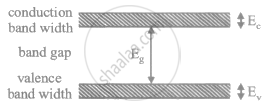Advertisements
Advertisements
प्रश्न
In a pure semiconductor, the number of conduction election 6 × 1019 per cubic metre. How many holes are there in a sample of size 1 cm × 1 mm?
उत्तर
Pure semiconductors are intrinsic semiconductors or semiconductors without any doping.
We know that for pure semiconductors, the number of conduction electrons is equal to the number of holes.
Number of electrons in volume 1 m3 = 6 × 1019
Number of holes in volume 1 m3 = 6 × 1019
Given volume:
V = 1 cm × 1 cm × 1 mm
\[\Rightarrow\] V = 1 × 10−2 × 1 × 10−2 × 10−3
Number of holes in volume 10-7 m3 .
N = 6 × 1019 × 10−7 = 6 × 1012
APPEARS IN
संबंधित प्रश्न
Draw the necessary energy band diagrams to distinguish between conductors, semiconductors and insulators.
How does the change in temperature affect the behaviour of these materials ? Explain briefly.
Draw separate energy band diagram for conductors, semiconductors and insulators and
label each of them.
Distinguish between a metal and an insulator on the basis of energy band diagrams ?
In semiconductors, thermal collisions are responsible for taking a valence electron to the conduction band. Why does the number of conduction electrons not go on increasing with time as thermal collisions continuously take place?
What is the resistance of an intrinsic semiconductor at 0 K?
Let np and ne be the number of holes and conduction electrons in an intrinsic semiconductor.
Indium antimonide has a band gap of 0.23 eV between the valence and the conduction band. Find the temperature at which kT equals the band gap.
The band gap between the valence and the conduction bands in zinc oxide (ZnO) is 3.2 eV. Suppose an electron in the conduction band combines with a hole in the valence band and the excess energy is released in the form of electromagnetic radiation. Find the maximum wavelength that can be emitted in this process.
Let ΔE denote the energy gap between the valence band and the conduction band. The population of conduction electrons (and of the holes) is roughly proportional to e−ΔE/2kT. Find the ratio of the concentration of conduction electrons in diamond to the in silicon at room temperature 300 K. ΔE for silicon is 1.1 eV and for diamond is 6.1 eV. How many conduction electrons are likely to be in one cubic metre of diamond?
The product of the hole concentration and the conduction electron concentration turns out to be independent of the amount of any impurity doped. The concentration of conduction electrons in germanium is 6 × 1019 per cubic metref conduction electrons increases to 2 × 1023 per cubic metre. Find the concentration of the holes in the doped germanium.. When some phosphorus impurity is doped into a germanium sample, the concentration o
The conductivity of an intrinsic semiconductor depends on temperature as σ = σ0e−ΔE/2kT, where σ0 is a constant. Find the temperature at which the conductivity of an intrinsic germanium semiconductor will be double of its value at T = 300 K. Assume that the gap for germanium is 0.650 eV and remains constant as the temperature is increased.
(Use Planck constant h = 4.14 × 10-15 eV-s, Boltzmann constant k = 8·62 × 10-5 eV/K.)
Two radioactive substances A and B have decay constants 3λ and λ respectively. At t = 0 they have the same number of nuclei. The ratio of the number of nuclei of A to those of B will be `1/"e"` after a time interval:
If the lattice constant of this semiconductor is decreased, then which of the following is correct?

A hole in a. p – type semiconductor is
For germanium crystal, the forbidden gas energy gap
In a common base configuration Ie = 1 mA α = 0.95 the value of base current is
The energy required by an electron to jump the forbidden band in silicon at room temperature is about ______.
